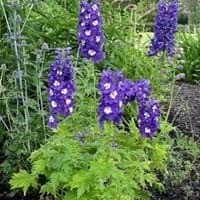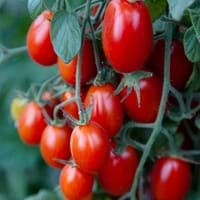Life Span
Perennial
Annual and Perennial
Type
Flowering Plants, Ornamental Plants, Shrubs
Vegetable
Origin
Africa
Hybrid origin, Mexico, Central America, South America
Types
Not Available
Cherry tomato, Beefsteak tomato, Medium tomato
Number of Varieties
Not Available
Habitat
gardens, meadows
Loamy soils, Shaded sites
USDA Hardiness Zone
Not Available
11-15
AHS Heat Zone
12 - 6
12-1
Sunset Zone
Not Available
A1, A2, A3, H1, H2, 1a, 1b, 2a, 2b, 3a, 3b, 4, 5, 6, 7, 8, 9, 10, 11, 12, 13, 14, 15, 16, 17, 18, 19, 20, 21, 22, 23, 24
Habit
Upright/Erect
Vining/Climbing
Minimum Width
Not Available
Flower Color
Blue, Indigo, Lavender, Light Purple
Yellow
Flower Color Modifier
Bicolor
Bicolor
Fruit Color
Non Fruiting Plant
Red
Leaf Color in Spring
Green
Green, Dark Green
Leaf Color in Summer
Light Green
Green, Dark Green
Leaf Color in Fall
Green, Yellow green
Green, Dark Green
Leaf Color in Winter
Green, Light Yellow, Tan
Green, Dark Green
Leaf Shape
Palmate and toothed
Elliptic, toothed
Plant Season
Spring, Summer, Fall, Winter
Spring, Summer, Fall
Sunlight
Full Sun, Partial Sun
Full Sun
Type of Soil
Clay, Loam, Sand
Loam, Sand
The pH of Soil
Acidic, Neutral, Alkaline
Neutral
Soil Drainage
Well drained
Well drained
Bloom Time
Not Available
Indeterminate
Tolerances
Heat And Humidity
Drought
Where to Plant?
Ground, Pot
Container, Ground, Pot
How to Plant?
Seedlings, Stem Cutting
Seedlings, Transplanting
Plant Maintenance
Medium
Medium
Watering Requirements
It cannot sustain wet-feet, Keep ground moist, Requires regular watering, Water more in summer
Allow to dry out slightly between watering, Do not water the foliage, Needs 2-3 times watering per week
In Summer
Lots of watering
Lots of watering
In Spring
Moderate
Moderate
In Winter
Average Water
Average Water
Soil pH
Acidic, Neutral, Alkaline
Neutral
Soil Type
Clay, Loam, Sand
Loam, Sand
Soil Drainage Capacity
Well drained
Well drained
Sun Exposure
Full Sun, Partial Sun
Full Sun
Pruning
Cut away fading foliage, Do not prune during shooting season, Remove damaged leaves, Remove deadheads
Remove damaged leaves, Remove dead branches, Remove dead leaves, Remove short branches, Remove short twigs
Fertilizers
High-phosphorous fertilizers used, Organic Flower Fertilizer
Apply 5-10-5 amounts
Pests and Diseases
Bacterial leaf spot, fungus, Mealybugs
Red blotch
Plant Tolerance
Heat And Humidity
Drought
Flower Petal Number
Single
Single
Fragrant Bark/Stem
No
Yes
Foliage Texture
Fine
Medium
Foliage Sheen
Matte
Matte
Attracts
Butterflies
Aphids, Bees, Butterflies, Mosquitos
Allergy
Severe allergen, Skin irritation, Skin rash, Throat itching, Vomiting
Diarrhea, gastro-intestinal problems, Headache, Itchiness, Vomiting
Aesthetic Uses
Beautification, Borders, Showy Purposes, Used for decorating walls, fences, gates, hedges, etc.
As decorated salad
Beauty Benefits
No Beauty Benefits
Acne, Glowing Skin, Maintains teeth healthy
Environmental Uses
Air purification
Air purification
Medicinal Uses
No Medicinal Use
Antioxidants, Metabolism
Part of Plant Used
Flowers
Fruits, Leaves
Other Uses
Used in making blue ink
Cosmetics, Culinary use, For making oil, Repellent
Used As Indoor Plant
No
Sometimes
Used As Outdoor Plant
Yes
Yes
Garden Design
Edging, Feature Plant
Container, Edible, Herb, Vegetable
Botanical Name
Delphinium elatum
LYCOPERSICON esculentum var cerasiforme 'Grape'
Common Name
Alpine delphinium, Delphium, Candle larkspur, Siberian larkspur, Musk Larkspur,
Grape tomato
In Hindi
अल्पाइन Delphinium
अंगूर टमाटर
In German
Alpine Delphinium
Traube Tomate
In French
Alpine Delphinium
tomate uva
In Spanish
Alpine Delphinium
tomate uva
In Greek
Alpine Δελφίνιο
ντομάτα σταφυλιών
In Portuguese
Alpine Delphinium
tomate uva
In Polish
Alpine Delphinium
pomidorowa z winogro
In Latin
Alpine Delphinium
uva tomatoes
Phylum
Tracheophyta
Magnoliophyta
Class
Magnoliopsida
Magnoliopsida
Order
Ranunculales
Solanales
Family
Ranunculaceae
Solanaceae
Clade
Angiosperms, Eudicots
Angiosperms, Asterids, Eudicots
Tribe
Not Available
Solaneae
Subfamily
Not Available
Solanoideae
Number of Species
Not Available
Importance of Alpine Delphinium and Grape Tomato
Want to have the most appropriate plant for your garden? You might want to know the importance of Alpine Delphinium and Grape Tomato. Basically, these two plants vary in many aspects. Compare Alpine Delphinium and Grape Tomato as they differ in many characteristics such as their life, care, benefits, facts, etc. Every gardener must at least have the slightest clue about the plants he wants to plant in his garden. Compare their benefits, which differ in many ways like facts and uses. The medicinal use of Alpine Delphinium is No Medicinal Use whereas of Grape Tomato is Antioxidants and Metabolism. Alpine Delphinium has beauty benefits as follows: No Beauty Benefits while Grape Tomato has beauty benefits as follows: No Beauty Benefits.
Compare Facts of Alpine Delphinium vs Grape Tomato
How to choose the best garden plant for your garden depending upon its facts? Here garden plant comparison will help you to solve this query. Compare the facts of Alpine Delphinium vs Grape Tomato and know which one to choose. As garden plants have benefits and other uses, allergy is also a major drawback of plants for some people. Allergic reactions of Alpine Delphinium are Severe allergen, Skin irritation, Skin rash, Throat itching and Vomiting whereas of Grape Tomato have Diarrhea, gastro-intestinal problems, Headache, Itchiness and Vomiting respectively. Having a fruit bearing plant in your garden can be a plus point of your garden. Alpine Delphinium has no showy fruits and Grape Tomato has showy fruits. Also Alpine Delphinium is flowering and Grape Tomato is not flowering . You can compare Alpine Delphinium and Grape Tomato facts and facts of other plants too.





